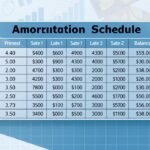Mortgage amortization is how you slowly pay off a loan over time. Each payment covers both the loan’s principal and the interest. The amortization schedule shows how each payment is split.
Knowing about mortgage amortization is key to smart mortgage choices. It can save you thousands of dollars over the loan’s life. It also helps you build equity in your home faster and plan your payments better.
Key Takeaways
- Mortgage amortization is the process of gradually repaying a loan over time through scheduled payments.
- Each payment covers both the loan principal and the accrued interest.
- The amortization schedule details the breakdown of every payment throughout the loan’s lifetime.
- Understanding mortgage amortization can help you save thousands in interest over the life of the loan.
- Amortization affects the rate at which you build equity in your home.
Understanding Mortgage Amortization Fundamentals
Understanding mortgage amortization is key for homebuyers. Your monthly payment has two main parts: principal and interest. The principal is the amount you borrow, and the interest is the cost of borrowing it.
What Makes Up Your Monthly Payment
At the beginning, most of your payment goes to interest because of the high loan balance. As you pay down the principal, more of your payment goes to reducing the loan balance. This continues until you pay off the loan.
The Role of Principal and Interest
Knowing how principal and interest work is crucial for managing your mortgage. An amortization calculator can help you see how your payments change over time. It shows how your money is used to pay off the loan.
How Payment Distribution Changes Over Time
Mortgages last from 15 to 30 years. Fixed-rate mortgages have the same payment each month. Adjustable-rate mortgages (ARMs) may have a fixed rate followed by rate changes. The way your payments are split between principal and interest changes over time, no matter the type of mortgage.
| Year | Total Interest Paid |
|---|---|
| 1 | $12,055 |
| 2 | $10,767 |
| 3 | $9,378 |
| 4 | $7,882 |
| 5 | $6,274 |
The table shows how interest paid decreases in the first five years of a 15-year, $200,000 mortgage with a 6% interest rate. This change in how payments are split is a key part of mortgage amortization that homebuyers need to understand.
“Understanding mortgage amortization is vital for homebuyers to comprehend how payments are distributed throughout the loan term.”
Types of Mortgage Amortization and Their Impact

Understanding different mortgage amortization types is key to a good loan experience. Let’s look at the main types and what they mean for your finances.
Fixed-Rate Amortization: This choice offers steady interest rates and payments, making budgeting simpler. Over time, more of your payment goes to paying off the loan.
Adjustable-Rate Amortization (ARM): ARMs have rates that change with the market, affecting your monthly payments. At first, more goes to interest, then to principal as the loan ages.
Interest-Only Amortization: Here, you only pay interest for a while before starting principal payments. This lowers your monthly costs but slows down building equity.
Negative Amortization: Payments are less than interest, making the loan balance grow. This can be risky, leading to higher costs and slower equity growth.
Each type has its pros and cons, affecting your loan’s cost and financial plan. Knowing these differences helps you pick the right mortgage for your goals.
| Amortization Type | Total Interest Paid | Total Loan Cost | Loan Term |
|---|---|---|---|
| 30-year Fixed-Rate | $164,813.42 | $364,813.20 | 30 years |
| 15-year Fixed-Rate | $75,397.58 | $275,398.20 | 15 years |
The 30-year loan has more interest but lower monthly payments. The 15-year loan has less interest but higher payments.
Grasping mortgage amortization is vital for smart financial planning. By understanding the options, you can choose the best mortgage for your future.
Smart Strategies for Managing Loan Payments

Exploring smart ways to manage your mortgage can save you a lot of money. You can make extra payments, use biweekly plans, or refinance. Each method has its benefits.
Making Extra Principal Payments
Making extra payments can cut down your interest and shorten your loan term. For example, adding $100 a month can save you over $26,500 in interest. If you pay $200 extra, you can save even more.
Biweekly Payment Advantages
Switching to biweekly payments can also help you pay off your loan faster. You’ll make 13 payments a year, which is like an extra payment. This can save you over $22,000 in interest.
Refinancing Opportunities
Refinancing is wise when interest rates drop. It can lower your monthly payments or shorten your loan term. Always think about how it fits with your financial goals.
Using these strategies can help you control your mortgage payments. You’ll pay less interest and build equity faster. Always talk to a financial expert to make sure these plans work for you.
Using Mortgage Calculators for Better Planning

Mortgage calculators are key for understanding your mortgage payments. They let you see how loan amounts, interest rates, and terms affect your payments. With an amortization schedule calculator, you can see each payment’s details, helping you make smart mortgage choices.
Trying out different payment scenarios with mortgage calculators can help you save on interest. For example, extra principal payments or a shorter loan term can cut down your total interest. This can make your mortgage more affordable.
These tools also help you compare different loans. This way, you can pick the one that suits your financial plans best. Knowing how amortization affects your payments lets you make choices that help you reach your financial goals.
| Mortgage Calculator | Amortization Schedule Calculator |
|---|---|
| Calculates monthly payments based on loan amount, interest rate, and term | Provides a detailed breakdown of each payment, showing how much goes towards principal and interest |
| Allows you to explore different loan scenarios and their impact on affordability | Helps visualize how the payment distribution changes over the life of the loan |
| Helps determine the total interest you’ll pay over the loan’s lifetime | Enables you to plan for early payoff strategies and understand the potential savings |
Using mortgage calculators helps you understand your mortgage better. They let you explore different payment scenarios. This way, you can make choices that fit your financial plans and help you save on interest.
“Mortgage calculators are indispensable tools for anyone navigating the complexities of homeownership and financial planning.”
Also Read: Analyzing Mortgage Movement In 2024
Conclusion
Understanding mortgage amortization is key to managing your finances well. It affects how much interest you pay, how fast you build equity, and your home’s total cost. By learning about amortization and using tools like mortgage calculators, you can make better loan choices. This could save you money over time.
Whether you’re buying your first home or refinancing, knowing about mortgage amortization is essential. It helps you plan your finances better and reach your goals faster. By optimizing your payments and using refinancing wisely, you can handle mortgage financing well.
By grasping mortgage amortization, you can control your loan better, lower interest payments, and grow your home’s value quickly. This knowledge is crucial for achieving financial stability and making your homeownership dreams come true.
FAQs
Q: What is an amortization schedule?
A: An amortization schedule is a table that outlines each monthly mortgage payment over the life of the loan, detailing how much goes toward the principal balance and how much goes toward interest.
Q: How can I use an amortization calculator?
A: You can use an amortization calculator to estimate your monthly mortgage payment, see the breakdown of principal and interest for each payment, and understand how extra payments can affect your loan repayment timeline.
Q: What factors influence my monthly mortgage payment?
A: Your monthly mortgage payment is influenced by the loan amount, interest rate, loan term, and property taxes. Other factors like mortgage insurance and homeowners association fees may also impact the total payment amount.
Q: What happens if I make extra payments on my home loan?
A: Making extra payments can reduce the principal balance of your mortgage faster, which means less interest paid over the loan’s life. This can lead to paying off your mortgage sooner and potentially saving thousands in interest costs.
Q: How does the lender determine my mortgage rates?
A: Lenders determine mortgage rates based on various factors including your credit score, loan amount, down payment, and current market conditions. A higher credit score typically results in lower mortgage rates.
Q: What does it mean to amortize a loan?
A: To amortize a loan means to gradually pay off the debt through regular payments over a specified period, where each payment is applied to both the principal and the interest, reducing the total amount owed over time.
Q: Can you explain negative amortization?
A: Negative amortization occurs when the monthly payments do not cover the interest cost, causing the principal balance to increase over time. This can happen with certain types of loans, such as adjustable-rate mortgages.
Q: How do I calculate amortization for my mortgage?
A: To calculate amortization for your mortgage, you can use a mortgage amortization calculator, which requires inputs like loan amount, interest rate, and loan term to generate an amortization schedule displaying each payment breakdown.
Q: What is an amortization table?
A: An amortization table is a detailed chart that shows each payment in a loan term, highlighting how much of each payment goes toward interest and how much is applied to the principal balance, allowing you to track your repayment progress.
Q: How does mortgage amortization work?
A: Mortgage amortization works by spreading out the repayment of the loan over a fixed period through equal monthly payments, where the payment amount remains constant while the portion going toward interest decreases over time as the principal balance is paid down.
Source Links
- https://comparemortgages.ca/blog/mastering-mortgage-math-a-step-by-step-guide-to-calculating-different-mortgage-payments/
- https://www.brightmoney.co/learn/mastering-loan-repayment-your-ultimate-guide-to-calculate-it
- https://fastercapital.com/content/Mastering-Mortgage-Amortization–A-Guide-to-Paying-Off-Your-Home-Loan.html






